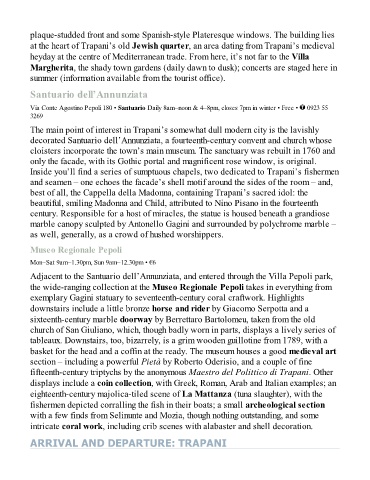Page 493 - The Rough Guide of Sicily
P. 493
plaque-studded front and some Spanish-style Plateresque windows. The building lies
at the heart of Trapani’s old Jewish quarter, an area dating from Trapani’s medieval
heyday at the centre of Mediterranean trade. From here, it’s not far to the Villa
Margherita, the shady town gardens (daily dawn to dusk); concerts are staged here in
summer (information available from the tourist office).
Santuario dell’Annunziata
Via Conte Agostino Pepoli 180 • Santuario Daily 8am–noon & 4–8pm, closes 7pm in winter • Free • 0923 55
3269
The main point of interest in Trapani’s somewhat dull modern city is the lavishly
decorated Santuario dell’Annunziata, a fourteenth-century convent and church whose
cloisters incorporate the town’s main museum. The sanctuary was rebuilt in 1760 and
only the facade, with its Gothic portal and magnificent rose window, is original.
Inside you’ll find a series of sumptuous chapels, two dedicated to Trapani’s fishermen
and seamen – one echoes the facade’s shell motif around the sides of the room – and,
best of all, the Cappella della Madonna, containing Trapani’s sacred idol: the
beautiful, smiling Madonna and Child, attributed to Nino Pisano in the fourteenth
century. Responsible for a host of miracles, the statue is housed beneath a grandiose
marble canopy sculpted by Antonello Gagini and surrounded by polychrome marble –
as well, generally, as a crowd of hushed worshippers.
Museo Regionale Pepoli
Mon–Sat 9am–1.30pm, Sun 9am–12.30pm • €6
Adjacent to the Santuario dell’Annunziata, and entered through the Villa Pepoli park,
the wide-ranging collection at the Museo Regionale Pepoli takes in everything from
exemplary Gagini statuary to seventeenth-century coral craftwork. Highlights
downstairs include a little bronze horse and rider by Giacomo Serpotta and a
sixteenth-century marble doorway by Berrettaro Bartolomeu, taken from the old
church of San Giuliano, which, though badly worn in parts, displays a lively series of
tableaux. Downstairs, too, bizarrely, is a grim wooden guillotine from 1789, with a
basket for the head and a coffin at the ready. The museum houses a good medieval art
section – including a powerful Pietà by Roberto Oderisio, and a couple of fine
fifteenth-century triptychs by the anonymous Maestro del Polittico di Trapani. Other
displays include a coin collection, with Greek, Roman, Arab and Italian examples; an
eighteenth-century majolica-tiled scene of La Mattanza (tuna slaughter), with the
fishermen depicted corralling the fish in their boats; a small archeological section
with a few finds from Selinunte and Mozia, though nothing outstanding, and some
intricate coral work, including crib scenes with alabaster and shell decoration.
ARRIVAL AND DEPARTURE: TRAPANI

